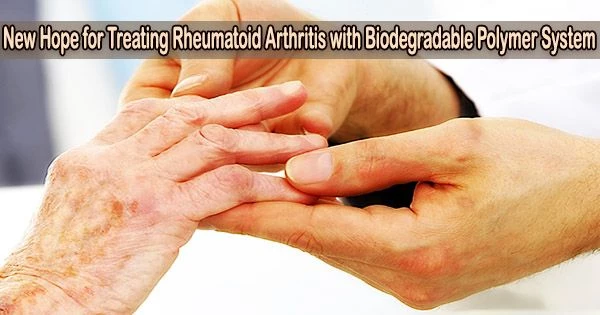Using the strength of the human immune system, a team of engineers from the University of California San Diego has created a biodegradable polymer system to treat rheumatoid arthritis, an autoimmune and inflammatory illness.
The study draws on prior work using all-trans retinoic acid (ATRA), a substance produced naturally by the body that aids in cell growth and development, as well as growing clinical interest in immune system modulation as a means of treating cancer and autoimmune diseases.
The team adds two significant additions to earlier approaches by approaching these problems from the viewpoint of a biomaterials engineering lab: local release and utilizing the shared microenvironment for long-lasting effectiveness.
With this method, encapsulated ATRA is injected directly into a joint affected by rheumatoid arthritis, where it remains in effect for at least several weeks. ATRA does this by converting disease-producing cells into regulatory T cells, which are then able to treat or prevent the disease elsewhere in the body.
“Essentially, our system turns the disease site into a factory that produces regulatory T cells,” said David A. McBride, a chemical engineering graduate student at UC San Diego supervised by nanoengineering professor Nisarg Shah. “It uses a biodegradable biomaterial to facilitate the timed release of ATRA, which reprograms T cells so they can treat disease.”
The research was published in the March 8, 2023 issue of Advanced Science. McBride is a coauthor on the paper.
“This is a very promising line of research utilizing the latest and greatest technology in immunoengineering to combat arthritis,” said Iannis Adamopoulous, an associate professor of medicine at Harvard’s Beth Israel Deaconess Medical Center, Department of Medicine, Division of Rheumatology.
Essentially, our system turns the disease site into a factory that produces regulatory T cells. It uses a biodegradable biomaterial to facilitate the timed release of ATRA, which reprograms T cells so they can treat disease.
David A. McBride
What is ATRA?
ATRA is a small molecule currently FDA approved to treat acute promyelocytic leukemia (APML). It may also be effective in treating autoimmune arthritis and reducing inflammation, according to 20 years of research.
However, that strategy depends on ATRA moving freely throughout the body, which can have negative side effects including immunosuppression and considerable off-target toxicity.
“Previous work established that ATRA has potential in treating autoimmune arthritis, but the route of administration precluded the work from being relevant to clinical translation,” said McBride.
ATRA can be injected directly into joints when it is encapsulated using biodegradable polymers, but as it diffuses out of the joint, it reaches circulation at much lower amounts, limiting or preventing adverse effects.
Patients would need many injections daily to get the same results without the regulated release made possible by the biomaterial encapsulation, which is typically not realistic.
How it works
When the human immune system is in good working order, helper T cells scour the body for microorganisms that cause disease. When a pathogen is detected, a helper T cell can recruit additional cells to help fight it.
“It’s kind of similar to how you might have police cars roaming the city, and when one sees a crime occurring, they call for backup to get the situation under control,” said McBride.
As a result of “mistaken identity,” which occurs when these cells attack a target that is actually a component of the body’s regularly functioning cells, many autoimmune disorders are caused. The subsequent proliferation of such pathogenic T cells, which McBride calls “bad apples,” can result from a combination of genetic and environmental factors and wreak havoc on the body when they summon large teams of immune cells for unnecessary standoffs.
For example, “in type 1 diabetes, you have bad apples that call in reinforcements against your pancreas,” said McBride. “In multiple sclerosis, it is against your neurons. In rheumatoid arthritis, it is against your joints. So, your immune system recognizes this as something to be attacked, and it goes and recruits a bunch of additional immune cells to these places and fights a war until all the pathogens are gone. Except that, in this case, it’s not attacking pathogens, but healthy parts of the body.”
Several existing strategies interfere with the chemical signals immune cells use to communicate, effectively stopping pathogenic T cells from recruiting additional immune cells without getting rid of the “bad apples.” Time-released ATRA reprograms them to act as regulatory T cells, or “good apples.”
These cells are still capable of identifying and activating in the joints, but instead of mobilizing more immune cells, they work to reduce the inflammation. The sustained-release formulation provides enough therapeutic exposure to tip the scales in places like joints where repeated injections are not advised.
The anti-inflammatory regulatory T cells perform better thanks to long-lasting changes made by ATRA to the way those cells read DNA. As a result, regulatory T cells unique to the sick tissue are produced, treating T cells at the location of the disease.
Then, when these cells are transferred to different disease sites, they can assist in reducing inflammation and encouraging healing. The cells’ disease-specificity prevents them from interfering with normal immune function, allowing them to enhance already available therapies or offer patients who require them options.
“The coolest part about this is that the treated site of disease, where the bad apples were previously proliferating, now becomes a place that can generate regulators that can now go patrol the body and actually prevent disease,” said McBride.
The limitations of existing approaches
Disease-modifying anti-rheumatic drugs (DMARDs) are often used to treat rheumatoid arthritis patients, and for many of them, this method is effective. Front-line DMARDs have some substantial drawbacks and only adequately treat roughly one-third of patients.
First, while using DMARDs, some patients become more susceptible to infectious disease and exhibit weaker responses to vaccines. In this regard, “the COVID-19 pandemic has brought a lot more understanding on the risks of immunosuppression into public awareness,” said McBride.
Additionally, there is no way to stop treatment if a risky infection develops because the majority of immunosuppressive medications used to treat rheumatoid arthritis remain in the body for up to two weeks.
Due to the complexity of the disease, it is usual for patients to utilize two or more treatments at once, which exacerbates the situation. Multiple strong immunosuppressants can increase the risk of cancer or infections.
“If you can instead have a treatment option that doesn’t have an immunosuppressive effect, you can really reduce the risk for patients that need multiple treatment modalities to keep their autoimmune disease in check,” McBride said.
Finally, immunosuppressive medications for some people may be beneficial for a while before losing their potency. This may occur if new disease pathways or antibodies that neutralize the drugs develop in the patients’ bodies. Potentially, new therapies like this one could supplement DMARDs, making up for declining efficacy or starting with lower doses.
“In well controlled patients, reducing or eliminating the need for immunosuppressive drugs is desirable,” said Shah. “However, when it is attempted, studies have shown that the disease can flare up again. So having a non-immunosuppressive option could go a long way.”
Research methods, challenges and next steps
Using a mixture of mouse and human cells, the researchers evaluated its biomaterial-encapsulation technique. They moved on to mice models of autoimmune arthritis after this produced encouraging results, getting closer to reproducing the extraordinary complexity of an actual case of autoimmune illness in a human person.
The effort entailed meticulously following the cells from their injection sites to other regions where they circulated and shown efficacy in battling disease, as well as several disease models, each created to illustrate a particular feature of the team’s idea.
Currently, the researchers are actively working toward commercialization. “As this is my first experience with something like this, it is difficult for me to estimate, but we are currently targeting approval to start clinical trials within five years,” said McBride. To evaluate possible commercialization routes, McBride has participated in the UC San Diego Institute for the Global Entrepreneur (IGE) NSF I-Corps and MedTech Accelerator programs.
The power of a multidisciplinary approach
When he entered graduate school at UC San Diego, McBride was focused on modeling complex signaling patterns in biological systems, for which rheumatoid arthritis provided many intriguing examples. He became more engaged as he gained awareness of the human side of the disease.
“I’m always surprised at how many people know someone fighting an autoimmune disease or are struggling with one themselves,” he said. “These experiences have really moved it from an interesting problem on paper that I’m trying to solve to a real, difficult problem in the lives of friends and family.”
This study needed a very interdisciplinary approach, drawing on input from specialists in immunology, clinical rheumatology, biomaterials design, and other fields. McBride credits the highly collaborative environment on the UC San Diego campus as a crucial factor in its success.
“UC San Diego doesn’t only promote academic collaboration, but also provides several resources for translating our discoveries beyond the lab and into the clinic,” he said. “Most recently, we are excited to have been awarded a UC San Diego internal grant under the Accelerating Innovations to Market program.”
Shah, McBride and paper co-senior author Nunzio Bottini, MD, PhD, a former Professor of Medicine at UC San Diego, now with Cedars-Sinai Medical Center, received the Accelerating Innovation to Market (AIM) award for 2023.
“By including high-caliber industry and investment experts in the selection process, it provides precious validation of the commercial potential of our idea,” Bottini said. “Plus, it supports the laboratory in completing proof of concept validation work needed to accelerate translation.”
















